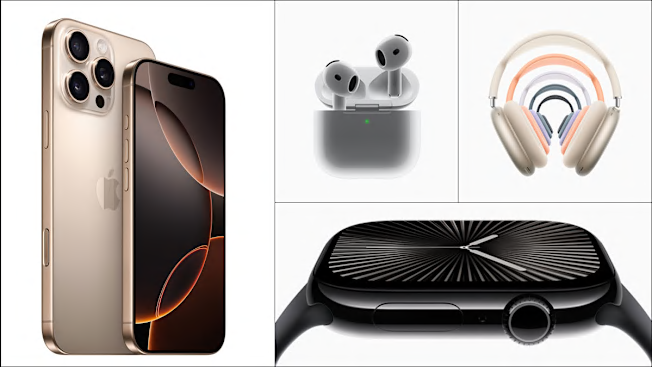Apple Unveils iPhone 16 Lineup, Watch Series 10, and AirPods 4
The phones feature a versatile camera button and bigger batteries. The smartwatches get sleep apnea detection, and the AirPods Pro will soon get a hearing aid function.

In its biggest product launch of the year, Apple unveiled its iPhone 16 lineup on Monday, as well as a slightly redesigned Apple Watch Series 10 and a noise-canceling version of its signature AirPods headphones.
The four new phones—the iPhone 16 and 16 Plus and the higher-end iPhone 16 Pro and 16 Pro Max—get new color options, zippier processors, and a versatile side button that grants you quick, easy-to-access camera functions, Apple says.
Apple Intelligence
Apple showed off some of the flashier features of Apple Intelligence, the integrated suite of generative AI tools that will be available in beta with the new iOS 18.1 operating system sometime next month.
As previewed earlier this year, Apple Intelligence will offer a range of features, from AI-enhanced writing tools, like suggested revisions that change the tone of an email or text, to automatic summaries of emails and texts in your notifications. It will also make searching through your photos and videos easier and more personalized, Apple says, by allowing you to make more targeted searches for, say, photos of “Mom dancing at the beach.”
Siri is also getting smarter. With iOS 18.1, the voice assistant will be able to better understand personal context and take more complicated actions across your devices. You can direct Siri to “send Mom the pictures from her birthday party,” for instance, and Siri will carry out the task by pulling from information in your own contacts and messaging history. You’ll also be able to type requests to Siri rather than only speaking aloud.
The iPhone 16 lineup is the first to be designed “from the ground up” with AI in mind, Apple says, including an A18 chip optimized for large generative models.
iPhone 16 Pro and 16 Pro Max
Apple’s latest flagship phones (shown below) don’t take a big leap forward, but the company introduced a few notable upgrades, like bigger screens and longer-lasting batteries.
The 16 Pro Max has the largest display on any iPhone at 6.9 inches (diagonally), up from 6.7 inches, and the screen on the 16 Pro jumps from 6.1 inches to 6.3 inches.

Photo: Apple Photo: Apple
The models come equipped with an A18 Pro chip and a 16-core neural engine, Apple says, making them particularly well-equipped to handle the AI processing load. The A18 Pro chip also contributes to the boost in battery life: The iPhone Pro models will now deliver up to 4 more hours of battery life than their predecessors, giving them the longest-lasting batteries of any iPhone.
The camera system includes a 48-megapixel camera, a new 48-megapixel ultrawide camera that can take up-close macro shots, and a 12-megapixel telephoto with 5x optical zoom. The iPhone 16 Pro Max is also capable of shooting 4K video at 120 frames per second. Like the rest of the iPhone 16 lineup, the Pro models will get a handy side camera button that you can press to snap a photo, hold down to take video, or slide to adjust features like style or zoom.
The color options are a new beige desert titanium and black titanium, bright white titanium, and natural titanium.
iPhone 16 and 16 Plus
The iPhone 16 and 16 Plus (shown below) also get a zippier processor, a slightly upgraded camera system, and two new side buttons—the Camera button and the versatile Action button already available on the iPhone 15 Pro and 15 Pro Max.
The screen sizes stay the same: 6.1 inches for the iPhone 16 and 6.7 inches for the 16 Plus. But like the higher-end models, the iPhone 16 and 16 Plus get a faster and more efficient A18 chip.
The dual camera system got a slight upgrade and now features a 48-megapixel “fusion” main camera with a 2x telephoto option, “giving users two cameras in one,” Apple says, and a new ultrawide camera that allows you to take up-close macro photos, just like the Pro models. The iPhone 16 and 16 Plus now come in bright ultramarine, teal, and pink, in addition to black and white.

Photo: Apple Photo: Apple
Apple Watch Series 10
While Apple Watch fans will be pretty familiar with the features on the new Series 10 (shown below)—including automatic workout detection, sleep tracking, and crash detection—there are a few notable upgrades.
The model has the largest display of any Apple Watch yet—bigger, even, than the high-end Watch Ultra—with 30 percent more screen area. This means watch wearers will see an extra line of text on the screen, useful for scanning messages and reading news alerts. Apple made the watch 10 percent thinner and lighter than the Series 9, too.
The Series 10 comes equipped with an S10 chip with a four-core neural engine. A new metal back on the watch also allows for a faster charge, up to 80 percent in just 30 minutes, the company claims, or up to 8 hours of sleep tracking with just 8 minutes of charging.

Photo: Apple Photo: Apple
While Apple Watches have long been equipped with sleep tracking, the Series 10 now helps detect sleep apnea by measuring breathing disturbances. Clearance for this feature by the Food and Drug Administration is coming soon, Apple says. Sleep apnea notifications are also coming to Series 9 and the Ultra 2.
The Series 10 also has a new OLED display that’s 40 percent brighter when viewed from an angle and extends farther down the sides of the case.
The Series 10 is available in 42 and 46 mm sizes and some new colors. You can get the watch with an aluminum case, now in black, rose gold, and the existing silver. It’s also available in a new titanium finish, in natural, gold, and slate.
Other changes include better background noise suppression when you’re taking calls and, for the first time, the ability to play other media, like music or podcasts, from the speakers rather than just phone call audio.
While there’s no new Ultra model, the Ultra 2 is getting a new titanium black finish, also available in stores on Sept. 20.
AirPods 4
Apple says the AirPods 4 (shown below), which feature an upgraded H2 chip, will deliver better sound along with personalized spatial audio. The design has also been modified slightly to provide a better fit. The big news, though, is a new $179 version that includes active noise canceling, a feature previously found only on the AirPods Pro and the company’s flagship over-the-ear Max headphones.
A transparency mode pipes in outside noise when you’re on the go and want to be aware of your surroundings. The AirPods 4 also get Apple’s conversation awareness feature, which lowers the volume of your content when you start talking to someone.
The AirPods 4 without active noise canceling cost $129. Both models are available for pre-order now. They arrive in stores on Sept. 20.

Photo: Apple Photo: Apple
The AirPods Pro 2, $249, remain unchanged, but Apple is introducing an update that allows the headphones to work as clinical-level over-the-counter hearing aids. The company has designed a 5-minute hearing test that involves tapping the screen on your iPhone when you hear tones with different volumes and frequencies. Apple claims that the test approaches the accuracy of pure tone audiometry done by an audiologist.
This results in a hearing profile—accessed through the Health app—that can be applied to your AirPods Pro 2 to turn them into a full-blown hearing aid, boosting specific sounds in real time to enhance normal conversation and environmental sounds. The findings are automatically applied to music, movies, and phone calls across all your Apple devices, too.
The AirPods Pro 2 update also includes hearing protection, activated by default across listening modes, when you’re at a concert or using noisy machinery. It reduces sound pressure levels while allowing a full-spectrum audio experience. The new features will be delivered in software updates to the AirPod Pro 2 and iOS 18. The hearing test and hearing aid capability will probably receive approval from the FDA and other regulators later this fall, according to Apple.
The AirPods Max are unchanged except for a universal USB-C charging port that replaces Apple’s proprietary Lightning port. But they come in several new colors, including midnight, blue, purple, orange, and starlight, and will soon receive spatial audio through an iOS update. The price remains the same at $550.
Correction: This article, published Sept. 9, 2024, has been updated to note that the iPhone 16 Pro Max can shoot 4K video at 120 frames per second, not the 15 Pro Max.




















